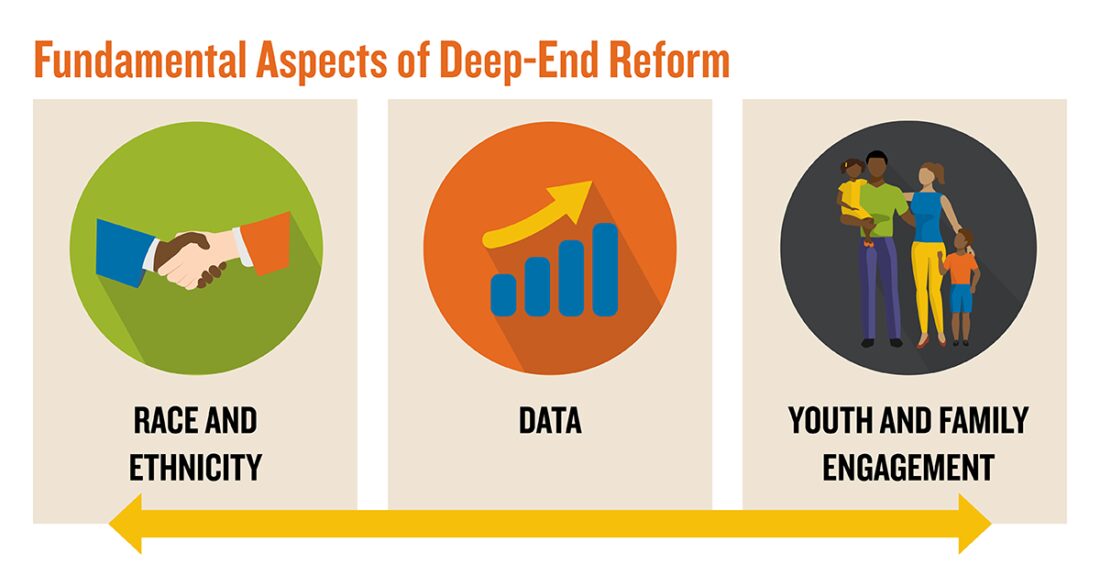Evaluation Identifies Key Features in Efforts to Reduce Juvenile Incarceration and Racial Inequity

What factors are important when it comes to reducing juvenile incarceration and other out-of-home placements? Leadership, organizational culture change and racial equity strategies — to name a few, according to a six-year evaluation of the Annie E. Casey Foundation’s reform efforts, which have realized dramatic reductions in both out-of-home placements for justice-involved youth and disparate outcomes between youth of color and white youth.
About the evaluation
A team from the Urban Institute and Mathematica conducted the evaluation, which centered on the process of the work rather than its outcomes. This approach enabled the team to inform the effort as it unfolded, document its evolution and share lessons that could benefit similar initiatives.
The team produced a package of products that includes:
- a report of overall findings;
- a brief on strategies used to engage youth and families;
- a brief on how sites worked to incorporate racial equity and inclusion;
- a brief on strategies to transform probation;
- a brief examining how the communities used data to develop strategies and assess their efforts; and
- an infographic summarizing key findings.
The report ends with technical appendixes that document reform activities at each site and describe the evaluation’s methods, which included surveys and extensive interview data.
The evaluation team also published an article in Youth Violence and Juvenile Justice that focuses on transforming juvenile probation through culture change.
Download the evaluation materials
What did the juvenile reform effort involve?
Youth of color are consistently overrepresented in courtrooms, detention centers, youth prisons and other residential institutions. This disparity is most extreme for youth in court-ordered institutions — often called the “deep end” of the juvenile justice system — and for youth who have been transferred from juvenile to adult criminal courts.
The Casey Foundation’s deep-end effort spans 12 demonstration sites across the United States and builds on its flagship juvenile justice reform movement — Juvenile Detention Alternatives Initiative® — which focuses on reforms at the early stages of the juvenile justice process.
Like JDAI, Casey’s deep-end effort employs data-driven strategies that move systems toward equity and specifically focus on youth of color. The 12 sites also engage community organizations and community members to increase opportunities for young people of color in their own neighborhoods.
Early results are encouraging, according to data collected by the Foundation. From their baseline years to 2018, participating sites collectively reduced out-of-home placements by 50% for all youth and 51% for African American youth. These changes — which occurred while juvenile crime rates improved — outpace reductions in confinement at the national level.
What did the evaluators learn about juvenile justice reform and juvenile incarceration?
Although sites shared no single characteristic that appeared linked to the success of deep-end activities, four factors emerged as key to implementing reform. These were:
- leaders in positions of power who were committed to reform;
- strong community partnerships;
- buy-in from staff, partners and related organizations; and
- substantial capacity to collect and analyze data.
The evaluators also recognized participating sites for:
- minimizing the number of times young people with misdemeanor charges were placed on probation;
- developing meaningful ways of working with young people who were assessed as high risk of rearrest;
- cultivating a shared understanding of the purposes of probation to sustain policy and practice changes; and
- leveraging technical assistance, sponsored by the Foundation, to foster worthwhile discussions with staff, partners and others.
Key challenges facing sites, according to the evaluation, were:
- changing system culture;
- forming new partnerships with families, youth and community; and
- collecting and analyzing data.
Jeffrey Poirier, a senior research associate at the Foundation who commissioned the evaluation, said the findings offer important lessons for others taking on complex efforts to reshape systems.
“This evaluation underscores the importance of being explicit about racial equity and equipping leaders with the understanding and tools they need to ensure that equity is the north star of their work,” Poirier explains. “It shows that embedding this kind of cultural change takes buy-in, time and resources — and that funders can play a catalytic role in making that happen.”





